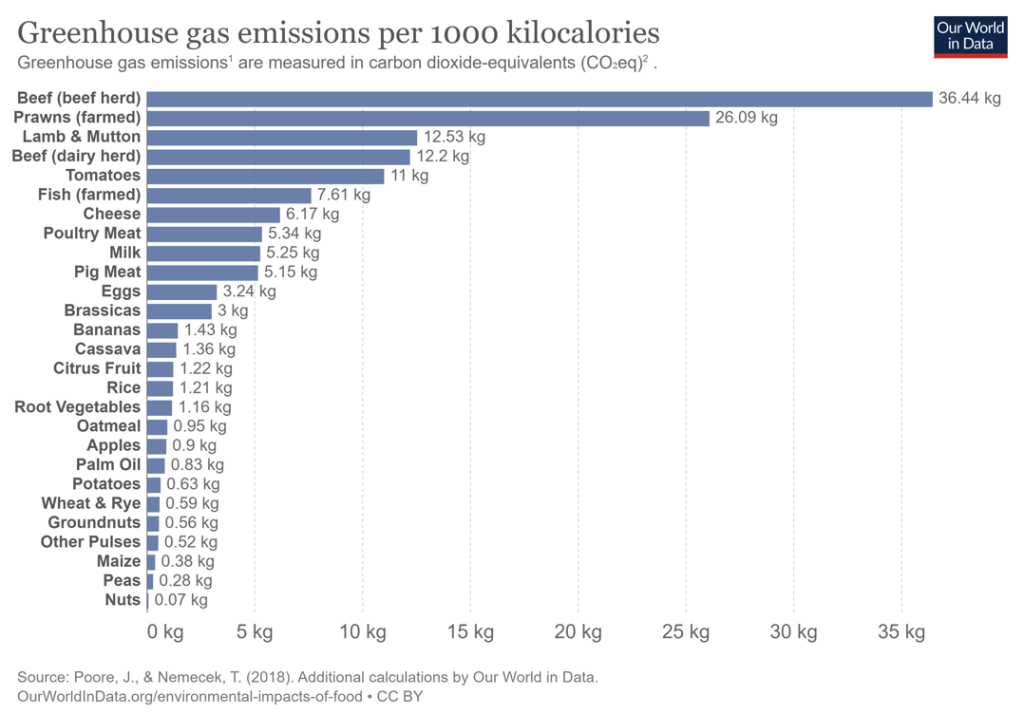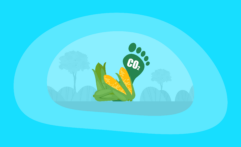What Is the Carbon Footprint of Celery? A Life-Cycle Analysis
Impactful Ninja is reader-supported. When you buy through links on our site, we may earn an affiliate commission.
Learn more
Learn more
.
Hey fellow impactful ninja ? You may have noticed that Impactful Ninja is all about providing helpful information to make a positive impact on the world and society. And that we love to link back to where we found all the information for each of our posts. Most of these links are informational-based for you to check out their primary sources with one click. But some of these links are so-called "affiliate links" to products that we recommend. First and foremost, because we believe that they add value to you. For example, when we wrote a post about the environmental impact of long showers, we came across an EPA recommendation to use WaterSense showerheads. So we linked to where you can find them. Or, for many of our posts, we also link to our favorite books on that topic so that you can get a much more holistic overview than one single blog post could provide. And when there is an affiliate program for these products, we sign up for it. For example, as Amazon Associates, we earn from qualifying purchases. First, and most importantly, we still only recommend products that we believe add value for you. When you buy something through one of our affiliate links, we may earn a small commission - but at no additional costs to you. And when you buy something through a link that is not an affiliate link, we won’t receive any commission but we’ll still be happy to have helped you. When we find products that we believe add value to you and the seller has an affiliate program, we sign up for it. When you buy something through one of our affiliate links, we may earn a small commission (at no extra costs to you). And at this point in time, all money is reinvested in sharing the most helpful content with you. This includes all operating costs for running this site and the content creation itself. You may have noticed by the way Impactful Ninja is operated that money is not the driving factor behind it. It is a passion project of mine and I love to share helpful information with you to make a positive impact on the world and society. However, it's a project in that I invest a lot of time and also quite some money. Eventually, my dream is to one day turn this passion project into my full-time job and provide even more helpful information. But that's still a long time to go. Stay impactful,Affiliate Disclosure
Why do we add these product links?
What do these affiliate links mean for you?
What do these affiliate links mean for us?
What does this mean for me personally?
![]()
Celery is the tenth most popular vegetable in the US. It contains only six calories per serving and is known for its anti-inflammatory, and heart health benefits. It is also a great source of potassium, calcium, vitamin K, folate, and flavonoids. Yet, much less is shared about the environmental impact, and especially the carbon emissions of celery. So we had to ask: What is the carbon footprint of celery?
Celery has a low carbon footprint of 0.27 kg (0.60 lb) of CO2e per pound of produce, which makes it one of the lowest carbon-emitting vegetables. The largest contributor to this footprint is the use of polyethylene bags for packaging.
In this article, we’ll walk you through the overall carbon emissions over the life-cycle of celery. From growing, to packaging, to transporting, you will learn how this vegetable affects the planet and discover some ways to reduce and offset the footprint.
Here’s How We Assessed the Carbon Footprint of Celery
The carbon footprint is one of the ways we measure the effects of our human-induced global climate change. It primarily focuses on the greenhouse gas (GHG) emissions associated with consumption, but also includes other emissions such as methane (CH4), nitrous oxide, and chlorofluorocarbons, and is generally expressed in carbon dioxide equivalents (CO2e).
“Carbon footprint: the amount of greenhouse gases and specifically carbon dioxide emitted by something (such as a person’s activities or a product’s manufacture and transport) during a given period”
Merriam Webster
Basically, it is the amount of carbon emitted by you as an individual or an organization providing you with goods and services – including celery:
- This includes GHG emissions from producing the products that we use and foods that we eat (e.g., power plants, factories or farms, and landfills)
- GHG emissions from fuel that we burn directly or indirectly (e.g., logistics and transportation, cooling or heating facilities),
- as well as the GHG emissions attributed to how we consume these products and foods.
To understand the carbon footprint of celery, we must assess its life-cycle and each stage’s sustainability. This life-cycle assessment (LCA) is a method to evaluate the environmental impacts of products and materials.
Here’s the Overall Carbon Footprint of Celery
The overall carbon footprint of celery is 0.27 kg (0.60 lb) of CO2e per pound of produce, which is very low. In fact, celery is one of the least carbon-intensive crops to grow. So, you can enjoy plenty of celery, knowing that it has a very small impact on the environment!
Celery is one of the most popular vegetables, so it is important to know the carbon footprint associated with this vegetable. Then, you can make sustainable choices when it comes to your food.
| The carbon footprint of celery | 0.27 kg (0.60 lb) of CO2e per pound of celery |
So, let’s have a look at each stage of the LCA of celery!
| The life-cycle stages of celery | Each stage’s carbon footprint |
| Growing of celery | The carbon footprint of growing celery makes up 23.95% of the overall carbon footprint of celery. The main contributing factor is water usage as this vegetable requires a lot of water during the growing process. |
| Harvesting, processing, and packaging of celery | The carbon footprint of harvesting, processing, and packaging celery makes up 55.11% of the crop’s overall carbon footprint. This high percentage can be attributed to the polyethylene bags used for packaging. |
| Transporting of celery | The carbon footprint of transporting celery makes up 17.55% of the vegetable’s overall carbon footprint. This is largely down to the chilled transport conditions, and the food miles involved in getting celery across the US. |
| End-of-life of celery | Celery makes up 6.5% of all salad waste. This is because it has a longer shelf life than other salad vegetables, like lettuce and tomatoes. So, the carbon footprint is low at this stage. However, it can be reduced further by only purchasing loose produce, as opposed to plastic-wrapped items, and composting the leftover waste. |
These four stages can be broken down in more detail to understand why the carbon footprint of celery is low in comparison to other foods.
What Is the Carbon Footprint of Growing Celery
The carbon footprint of growing celery makes up 23.95% of the overall carbon footprint of celery. The main contributing factor is water usage as this vegetable requires a lot of water during the growing process.
There are many factors which impact the carbon footprint of growing celery, such as land, water, and pesticide usage.
Which factors impact the carbon footprint of growing celery?
- How do celery grow: Celery grows above ground, and can reach up to a meter tall. This crop thrives in cool, humid conditions. In the UK, there are some trials to make growing celery carbon neutral, by growing it on rewetted peat soil, which absorbs carbon emissions.
- What is the growth duration of celery: Celery is a long-season crop, which can take up to 140 days to harvest. It is more difficult to grow than most vegetables, due to its long germination period, which contributes to its carbon footprint.
- What is the land usage of celery: One acre of farm can grow between 32,000-42,000 celery plants. This is much higher than the optimal plant populations for broccoli which is 14,000-24,000 broccoli plants per acre. Since the land usage is relatively efficient for celery, the carbon emissions are low.
- What is the water usage of celery: Celery requires almost twice the amount of water than most other vegetables (1-2 inches per week), because it needs marshy soil to grow. This is one of the most significant parts of celery’s overall carbon footprint.
- What is the pesticide and fertilizer usage of celery: In 95% of celery samples, a pesticide is found, and 85% of samples contain multiple pesticides. In fact, the Environmental Working Group includes celery as the eleventh most pesticide-laden food in their annual ‘Dirty Dozen’ studies on pesticide usage. Pesticides produce carbon emissions through manufacturing, transportation and application to crops, so celery is a high-impact vegetable in this regard. To lessen the carbon footprint of celery, opt for organic produce.
In short, the growing process is a significant part of the overall carbon footprint of celery. The main factors for this are the long growing time, the amount of water needed, and pesticide usage.
What Is the Carbon Footprint of Harvesting, Processing, and Packaging Celery
The carbon footprint of harvesting, processing, and packaging celery makes up 55.11% of the crop’s overall carbon footprint.This high percentage can be attributed to the polyethylene bags used for packaging.
The harvesting and processing of celery generally has quite a low carbon footprint, because it is harvested by hand and it’s often sold as fresh produce rather than processed. However, the use of non-recyclable packaging worsens the overall carbon footprint of celery.
Which factors impact the carbon footprint of harvesting, processing, and packaging celery?
- How are celery harvested: Celery is primarily hand-harvested, which produces lower emissions. However, celery grown for processing is usually harvested by machine. Celery fields are cut only once to ensure uniform crops, which is not ideal for carbon emissions.
- How are celery processed: After harvesting, celery is cooled and kept in cold storage, at around 0-2oC, until shipped. The energy needed to keep produce at this temperature has a significant impact on carbon emissions. However, most celery is sold as a fresh vegetable so excess resources are not wasted on processing. This method helps to offset the CO2 emissions for cold storage, meaning that the overall carbon footprint is low.
- How are celery packaged: Celery is shipped in wooden or cardboard boxes, and is often sold in individual polyethylene bags. This plastic packaging is the main cause of over 55% of the crop’s overall carbon footprint. Try to avoid plastic packaging for a much more sustainable choice.
In short, the plastic packaging of celery is a major part of celery’s carbon footprint, but it can be avoided by choosing plastic-free produce.
What Is the Carbon Footprint of Transporting of Celery
The carbon footprint of transporting celery makes up 17.55% of the vegetable’s overall carbon footprint. This is largely down to the chilled transport conditions, and the food miles involved in getting celery across the US.
Since the majority of celery is grown in the US, the carbon footprint is relatively low.
Which factors impact the carbon footprint of transporting celery?
- Where is celery grown: The US is the number one producer of celery worldwide. Most celery is grown in California and Michigan, with California growing 80% of the country’s crop. During summer, the milder temperatures in Michigan mean that the crop can thrive there when California is too hot. Because it is grown locally, and there are not a lot of exports from overseas, the carbon emissions are low for celery at this stage.
- How is celery transported: Celery is transported in chilled containers, which are needed to keep the crop as cold as possible without freezing. This use of refrigerators produces a higher carbon footprint. However, since the majority of celery consumed is native to the US, it does not have to be shipped from overseas. This keeps the carbon footprint lower than other vegetables, such as tomatoes.
In short, carbon emissions are released through the transportation and refrigeration needs of celery. However, luckily it is a native crop, which does not have to be imported, meaning that the carbon footprint is not overly inflated through transportation.
What Is the Carbon Footprint of the End-of-Life of Celery
Celery makes up 6.5% of all salad waste. This is because it has a longer shelf life than other salad vegetables, like lettuce and tomatoes. So, the carbon footprint is low at this stage. However, it can be reduced further by only purchasing loose produce, as opposed to plastic-wrapped items, and by composting the leftover waste.
Celery is a compostable product, which can create sustainable fertilizer. However, sadly it often ends up rotting in landfill. Cardboard cartons can be recycled or will biodegrade, but the plastic packaging is harder to recycle. Waste can be reduced by choosing to buy unwrapped produce, and trying to throw less food away.
Which factors impact the carbon footprint of the end-of-life of celery?
- How is celery disposed of: Celery only makes up 0.004% of overall food waste. Over 40% of this celery is wasted on farms, due to aesthetic consumer preferences. The resources used to grow these crops just to discard them is enormous, and negatively impacts the carbon footprint of celery. To reduce this waste, the demand for ‘wonky fruit’ has been rising. Buying imperfect produce will lead to farmers throwing away less crops. Celery is completely compostable, though food waste in landfill is a big problem for the environment. If you have celery that is looking a bit floppy, it can usually be revived by a soak in ice water.
- How is the packaging of celery disposed of: Plastic packaging is difficult to recycle. However, many of the polyethylene bags used for the packaging celery are recyclable, as long as the polyethylene is not bonded with other plastics. This is because polyethylene is generally only recycled to make like-for-like products. Still, it is much more sustainable to buy loose produce. A lot of plastic that we recycle ends up on the other side of the world, causing a threat to developing countries. So, it is not as good for the environment as we may imagine.
In short, food and plastic waste contribute to this plant’s carbon footprint. Steps can be taken to reduce your individual waste, through buying loose produce, and not over-consuming or throwing out celery.
How Does the Carbon Footprint of Celery Compare to Other Types of Food
Celery has a low carbon footprint. In comparison to the ten most popular vegetables, it ranks as one of the lowest, alongside broccoli. So, if you are looking for a sustainable snack that is also super healthy, reach for a stick of celery.
Let’s see how celery ranks in comparison to other types of vegetables.
How Does the Carbon Footprint of Celery Compare to Other Types of Vegetables
Celery is one of the must carbon-friendly vegetables, alongside broccoli. Celery has around a third of the carbon emissions associated with bell peppers and salad mix.
How Does the Carbon Footprint of Celery Compare to Other Types of Food in General
Celery has a low carbon footprint compared to other types of foods, and even in comparison to other fruits and vegetables. It has one of the lowest carbon footprints out of the most popular vegetables.
When it comes to greenhouse gas emissions (GHG), foods are often compared in terms of emissions per 1,000 kilocalories (as opposed to their weight in lbs or kg). Celery ranks as on of the lowest greenhouse gas emitting produce, alongside other root vegetables.

Though the carbon emissions for celery are relatively low, there are some ways to reduce and offset your carbon footprint. When you do purchase celery, try to be mindful of the ways you can lessen your environmental impact.
How Can You Reduce and Offset Your Personal Carbon Footprint
All of the food you eat will have some form of carbon footprint, especially when you buy foods with high CO2e. However, there are ways to offset and reduce your personal carbon footprint.
There are a few easy techniques to buy more eco-friendly celery, and you can also find ways to offset the carbon footprint after your purchase.
How Can You Reduce Your Carbon Footprint When Shopping for Celery
When shopping for celery, consider these ways to lessen your impact on the environment.
- Opt for packaging-free produce: If you are unable to find loose celery, choose cardboard-based packaging as opposed to plastic. Plastic waste is hard to recycle and creates an abundance of issues, but you can also reduce the impact of recycling by purchasing fruit and vegetables with no packaging at all.
- Buy locally: Driving up demand for local produce reduces food miles and lessens greenhouse gas emissions. Make sure you buy celery grown in the US, instead of imported from other countries, to ensure you have a more positive impact. Buying from farmers local to your area is even more beneficial.
- Choose organic celery: Organic celery produces a much lower carbon footprint than non-organic produce, due to the lack of pesticide production, distribution, and the overall higher health of soil for crops, insects, and animals.
Taking these actions are a great way to lessen your own carbon footprint, but there are also ways to offset the impact of consuming celery as well.
How Can You Offset Your Personal Carbon Footprint
Carbon offsets are reductions in carbon emissions that are used to compensate for carbon emissions occurring elsewhere – for example for the carbon emissions that are associated with celery. These are measured in tons of CO2 equivalents and are bought and sold through international brokers, online retailers, and trading platforms on what is known as the global carbon offset market.
“Carbon Offset: a way for a company or person to reduce the level of carbon dioxide for which they are responsible by paying money to a company that works to reduce the total amount produced in the world, for example by planting trees”
Oxford Dictionary
In terms of celery – and indeed all food types – there will always be a carbon footprint, because of the resources it takes to get your food from farms to the place where you’ll eventually eat them. And while there are ways to reduce your carbon footprint when shopping for celery, carbon offsets would be a way to reduce your CO2e emissions all the way down to net zero (or even to become climate positive).
However, when you purchase carbon offsets, it’s important that they actually make a difference in offsetting (aka reducing) total carbon emissions. To achieve that, the following are key criteria:
- Carbon offset projects have to be effective (different projects have different effectiveness rates)
- Carbon offset projects have to be additional
- Carbon offset projects have to be permanent
- The claims from carbon offset projects have to be verifiable
To find the best carbon offsets for you personally, check out our full guide on the best carbon offsets for individuals, where you’ll also learn more about how these carbon offset projects work, what their respective offsetting costs are, and what your best way would be to offset your own carbon emissions.
Final Thoughts
Celery is overall a wonderful choice of sustainable vegetable. However, you can reduce your carbon footprint even further by eating organic, buying plastic-free, and purchasing local produce. As there is an interest in peat farming, celery may be one of the first crops to be farmed in a carbon-neutral way.
Stay impactful,

Sources
- Statista: Most consumed vegetables in the United States in 2021
- BBC Good Food: Top 5 health benefits of celery
- Carbon Cloud: Organic Celery Hearts
- Britannica: Carbon footprint
- Science Direct: Life-cycle assessment (LCA)
- MIT SMR: Strategic Sustainability Uses of Life-Cycle Analysis
- AgriFarming: Celery Farming Information Guide
- The Wildlife Trust for Lancashire, Manchester, and North Merseyside: Could Celery Help Fight Climate Change?
- Agricultural Marketing Resource Centre: Celery
- USDA: Celery
- PennState Extension: Broccoli Production
- Harvest to Table: How to Plant, Grow, and Harvest Celery
- PH & G: How much water does celery need?
- Environmental Working Group: Big Ag’s “Celery Calculator” Lowballs Pesticide Risk
- Kim Pearson: Pesticides in Produce: 2022’s Clean Fifteen and Dirty Dozen
- Soil Association: Why is Organic Better for the Planet?
- University of California: Celery Production in California
- Food Climate Research Network: Fruit & Vegetables & UK Greenhouse Gas Emissions
- Fruits and Vegetables: Celery – Packaging
- Tasting Table: Which Country Produces the Most Celery?
- Cargo Handbook: Celery
- Impactful Ninja: What is the Carbon Footprint of Tomatoes?
- Wrap: The Food We Waste
- New Food Magazine: Food waste: digesting the impact on climate
- Full Harvest: Food Waste: A Bigger Issue Than We Thought.
- Edie: Wonky fruit & veg: turning an environmental problem into a social solution
- WWF: Fight climate change by preventing food waste
- Recycle This: How can I reuse, recycle or use up floppy celery?
- Lets Recycle: Supermarkets to take back plastic film in-store
- Sesotec: Recycling more packaging – potential for PE and PP
- Live Science: The Plastic We ‘Recycle’ Is Actually Horrible for the Environment
- Our World in Data: Greenhouse Gas Emissions per 1000 kilocalories
- State of the Planet: Is Organic Food Really Better for the Environment?
- Impactful Ninja: What Are the Best Carbon Offsets for Individuals: Complete 2024 List




